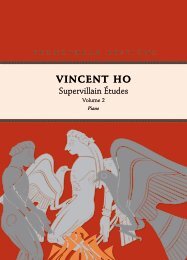Thunder Drum (Preview)
by Christos Hatzis | Orchestra and Digital Audio
by Christos Hatzis | Orchestra and Digital Audio
- TAGS
- digital-audio
- hatzis
- drum
- thunder
You also want an ePaper? Increase the reach of your titles
YUMPU automatically turns print PDFs into web optimized ePapers that Google loves.
Programme Note<br />
I Elegy for a Lost World<br />
II Games<br />
III Reconstitution<br />
From the composer:<br />
Although the music of <strong>Thunder</strong> <strong>Drum</strong>’s outer movements are reminiscent<br />
of 19th century Western European music and more recent epic film<br />
soundtracks, the underlying theme is informed by a vision of human<br />
prehistory expounded by the American mystic Edgar Cayce (1877-1945)<br />
related to the shifting fortunes of what has been traditionally known as<br />
the “red race”, the native inhabitants of the north and central regions<br />
of the American continent. A great and lasting influence in my thinking<br />
and artistic imagination, Edgar Cayce had mentioned in several of his<br />
trance utterances that the antediluvian world we know through legend as<br />
“Atlantis” was an advanced civilization dominated by the “red race”, which<br />
had reached knowledge and technological heights comparable to our own.<br />
It fell spectacularly, having pushed its unquenchable thirst for ever increasing<br />
energy and power to ecological havoc, as our current civilization too is in<br />
danger of reaching with an exponentially increasing likelihood.<br />
The first movement, Elegy for a Lost World, is a musical meditation on<br />
this loss, which is traumatically felt by our collective psyche as deep<br />
seated memory, in spite of the absence of any external evidence for the<br />
existence and loss of such an advanced civilization in our collective past.<br />
Beginning and developing along 19th century European common harmonic<br />
and melodic practice (another vanishing world), the music is a vague<br />
reminiscence of a two-theme classical sonata form. The melodic/harmonic<br />
discourse is gradually overtaken by denser chromaticism and accompanying<br />
musical tension, exacerbated by the technological “fly by” sound effects of<br />
the playback audio which are becoming ever more prominent.<br />
Games, the second movement, is a great leap to the present moment.<br />
The industrial-like “quantized” loops in the playback audio, with their<br />
unexpected twists and turns, are combined with pre-recorded samples of<br />
Inuit throat singer Tanya Tagaq. This sonic background constantly challenges<br />
an agile orchestra to technically rise to its unpredictable rhythmic demands,<br />
a task increasingly frustrated by metric modulations and other devices of<br />
rhythmic complexity.<br />
Without any pause, Reconstitution, the third movement, begins quietly<br />
with a timid thematic development of the aggressive modal gestures that<br />
concluded the previous movement. The music once more picks up pace and<br />
energy and, this time around, it ends in an epic, triumphant but also hollow<br />
ending with the opening theme of <strong>Thunder</strong> <strong>Drum</strong> modulating to an altered<br />
major-like mode. In the aftermath of this triumphant conclusion, however,


















